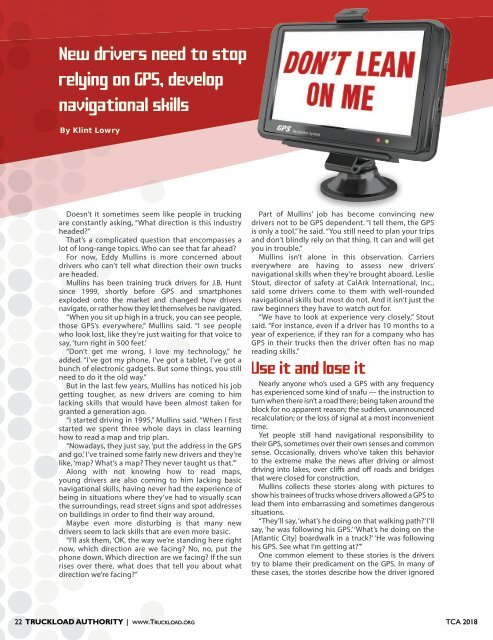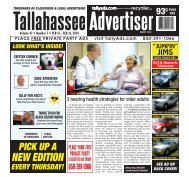Truckload Authority - August/September 2018
Create successful ePaper yourself
Turn your PDF publications into a flip-book with our unique Google optimized e-Paper software.
By Klint Lowry<br />
Doesn’t it sometimes seem like people in trucking<br />
are constantly asking, “What direction is this industry<br />
headed?”<br />
That’s a complicated question that encompasses a<br />
lot of long-range topics. Who can see that far ahead?<br />
For now, Eddy Mullins is more concerned about<br />
drivers who can’t tell what direction their own trucks<br />
are headed.<br />
Mullins has been training truck drivers for J.B. Hunt<br />
since 1999, shortly before GPS and smartphones<br />
exploded onto the market and changed how drivers<br />
navigate, or rather how they let themselves be navigated.<br />
“When you sit up high in a truck, you can see people,<br />
those GPS’s everywhere,” Mullins said. “I see people<br />
who look lost, like they’re just waiting for that voice to<br />
say, ‘turn right in 500 feet.’<br />
“Don’t get me wrong, I love my technology,” he<br />
added. “I’ve got my phone, I’ve got a tablet, I’ve got a<br />
bunch of electronic gadgets. But some things, you still<br />
need to do it the old way.”<br />
But in the last few years, Mullins has noticed his job<br />
getting tougher, as new drivers are coming to him<br />
lacking skills that would have been almost taken for<br />
granted a generation ago.<br />
“I started driving in 1995,” Mullins said. “When I first<br />
started we spent three whole days in class learning<br />
how to read a map and trip plan.<br />
“Nowadays, they just say, ‘put the address in the GPS<br />
and go.’ I’ve trained some fairly new drivers and they’re<br />
like, ‘map? What’s a map? They never taught us that.’”<br />
Along with not knowing how to read maps,<br />
young drivers are also coming to him lacking basic<br />
navigational skills, having never had the experience of<br />
being in situations where they’ve had to visually scan<br />
the surroundings, read street signs and spot addresses<br />
on buildings in order to find their way around.<br />
Maybe even more disturbing is that many new<br />
drivers seem to lack skills that are even more basic.<br />
“I’ll ask them, ‘OK, the way we’re standing here right<br />
now, which direction are we facing? No, no, put the<br />
phone down. Which direction are we facing? If the sun<br />
rises over there, what does that tell you about what<br />
direction we’re facing?”<br />
Part of Mullins’ job has become convincing new<br />
drivers not to be GPS dependent. “I tell them, the GPS<br />
is only a tool,” he said. “You still need to plan your trips<br />
and don’t blindly rely on that thing. It can and will get<br />
you in trouble.”<br />
Mullins isn’t alone in this observation. Carriers<br />
everywhere are having to assess new drivers’<br />
navigational skills when they’re brought aboard. Leslie<br />
Stout, director of safety at CalArk International, Inc.,<br />
said some drivers come to them with well-rounded<br />
navigational skills but most do not. And it isn’t just the<br />
raw beginners they have to watch out for.<br />
“We have to look at experience very closely,” Stout<br />
said. “For instance, even if a driver has 10 months to a<br />
year of experience, if they ran for a company who has<br />
GPS in their trucks then the driver often has no map<br />
reading skills.”<br />
Use it and lose it<br />
Nearly anyone who’s used a GPS with any frequency<br />
has experienced some kind of snafu — the instruction to<br />
turn when there isn’t a road there; being taken around the<br />
block for no apparent reason; the sudden, unannounced<br />
recalculation; or the loss of signal at a most inconvenient<br />
time.<br />
Yet people still hand navigational responsibility to<br />
their GPS, sometimes over their own senses and common<br />
sense. Occasionally, drivers who’ve taken this behavior<br />
to the extreme make the news after driving or almost<br />
driving into lakes, over cliffs and off roads and bridges<br />
that were closed for construction.<br />
Mullins collects these stories along with pictures to<br />
show his trainees of trucks whose drivers allowed a GPS to<br />
lead them into embarrassing and sometimes dangerous<br />
situations.<br />
“They’ll say, ‘what’s he doing on that walking path?’ I’ll<br />
say, ‘he was following his GPS.’ ‘What’s he doing on the<br />
[Atlantic City] boardwalk in a truck?’ ‘He was following<br />
his GPS. See what I’m getting at?’”<br />
One common element to these stories is the drivers<br />
try to blame their predicament on the GPS. In many of<br />
these cases, the stories describe how the driver ignored<br />
22 TRUCKLOAD AUTHORITY | www.<strong>Truckload</strong>.org TCA <strong>2018</strong>

















